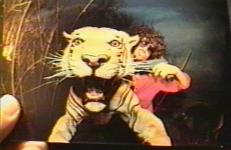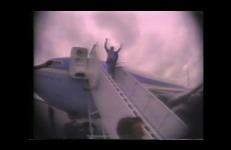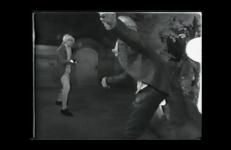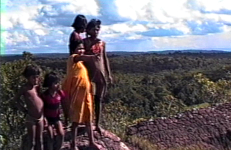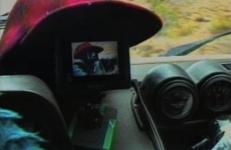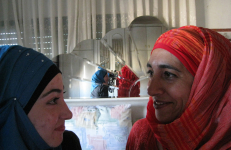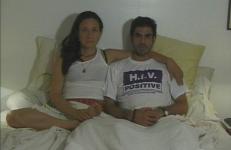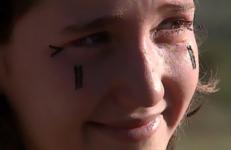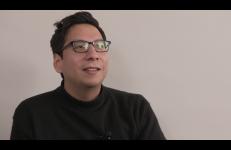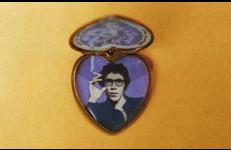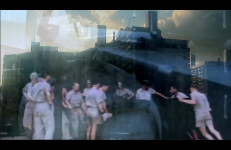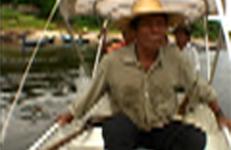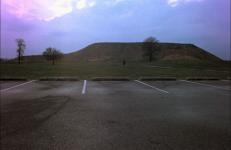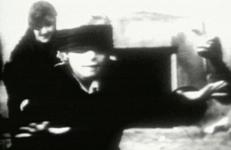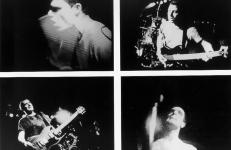Storms threaten to tarnish the Golden State as I wander through the rooms of my apartment, seeking a high in the lowering barometric pressure. Many mementos create a series of flashbacks to warm the cockles in our most secret places—some of those places being blatantly revealed in this cockle-warming picture.
Documentary
In the wake of Lord of the Universe, TVTV planned to cover the impeachment of Richard Nixon, but, unfortunately, Nixon resigned. The group made a ninety-degree turn to covering the “first hundred days” of the Gerald Ford administration, a cavalcade of photo ops and campaign appearances. In Part One of the four-part series, entitled WIN (referring to the Ford slogan, “Whip Inflation Now”), TVTV goes on a whirlwind across-country trek with Ford, stopping in Sioux City, Iowa, Salt Lake City, and Portland. The show is more about Ford’s public than Ford.
Arguably, the most successful of the four “Gerald Ford’s America” shows was “Chic To Sheik,” a TVTV tour of the private culture of the official Washington. Lead by Megan Williams, they blithely move around an official White House tea for Betty Ford at the beginning and cavort at the Shah of Iran’s birthday party at the Iranian Embassy at the end. Shot with almost open access because this was when even public people, in private, were innocents before a documentary camera. Washington Post Society Editor, Betty Beale, leads the way. A gem.
Chief Pedro Mãmãindê (who directed the proceedings and the shoot itself) describes the necessity of strengthening the girls of his village by secluding them after their first menses. After several months, the village throws a party, with singing, feasting, and the ritual abduction of the girl by an allied village. When the Nambiquara of Mato Grosso see videotape of themselves performing this ritual, the excess of Western clothing makes them uncomfortable. The ritual is then re-enacted with traditional body painting and adornment.
Chief Pedro Mãmãindê (who directed the proceedings and the shoot itself) describes the necessity of strengthening the girls of his village by secluding them after their first menses. After several months, the village throws a party, with singing, feasting, and the ritual abduction of the girl by an allied village. When the Nambiquara of Mato Grosso see videotape of themselves performing this ritual, the excess of Western clothing makes them uncomfortable. The ritual is then re-enacted with traditional body painting and adornment.
Spiro traveled for one year on the backroads of the southern United States gathering footage for this mobile video project. Accompanied by her dog Sam and a video camera, she travels from Virginia to Texas and back. Her van (which breaks down frequently) serves as office, apartment, editing suite, and runabout.
Nurit Sharett visited the city of Hebron over the course of a year, teaching video art to a group of young Palestinian women. Over time the artist established firm relationships with three of her students and their families. The video documents everyday life in that microcosm, dissimilar to any other city.
Habit is an autobiographical documentary that follows the current history of the AIDS epidemic along dual trajectories: the efforts of South Africa’s leading AIDS activist group, the Treatment Action Campaign, struggling to gain access to AIDS drugs and the daily routine of the videomaker, a veteran AIDS activist in the U.S. who has been living with AIDS for more than ten years.
Indians In Brazil is an educational series for Brazilian public schools that invites students to experience cultural diversity. Four teenagers are invited to discover a new world and participate in Indian daily life in two different communities. They show their emotions, curiosity and fears, and are surprised by their new friends.
Indians In Brazil is an educational series for Brazilian public schools that invites students to experience cultural diversity. Four teenagers are invited to discover a new world and participate in Indian daily life in two different communities. They show their emotions, curiosity and fears, and are surprised by their new friends.
The video hovers tentatively between therapy, documentary, poetics and mystic traipsery and ends, like all good things, in surrender to song. There is a challenge presented (the challenge to engage earnestly with the piece as it requests) to fall into the breathing and pacing presented, and the challenge to view the video as a discrete piece of art at the same time. The piece relies heavily on the text, the disembodied Virgil through which the words become musical, instructive and (due to the absence of image) visual.
In this interview with Carl Bogner, Sky Hopinka (b. 1984) discusses his process of becoming a video artist and his personal approach to documenting Indigenous landscapes and cultures. Hopinka is a member of the Ho-Chunk Nation of Wisconsin, and he is also an educator in Chinuk Wawa, a language indigenous to the Lower Columbia River Basin. Hopinka’s practice involves experiments within the cinematic language of documentary.
Matt Wolf returns to Joe Brainard's iconic poem I Remember (1970) in this videowork. His archival montage combines audio recordings of Brainard reading from the poem, as well as an interview with his lifelong friend and collaborator, the poet Ron Padgett. The result is an inventive biography of Joe Brainard, and an elliptical dialog about friendship, nostalgia, and the strange wonders of memory.
I Was There is a trilogy of experimental documentary films that explores the problem of radiation, our society's fading collective memory of the atomic bombing of Hiroshima and Nagasaki, and the unresolved debate between ethics and science. These series concern the immediate effects of weaponized nuclear technology, as invisible poison, on the human body.
A myth illustrated on the stones of a waterfall, the reconstruction of a great communal hut, the attempt to recover objects kept for years in a museum in Manaus. In IAUARETÊ, Waterfall of the Jaguars the Tariano Indians, of the North-western Amazon, after decades of missionary catechism, decide to make a cultural record for future generations.
Direction: Vincent Carelli
Photography: Vincent Carelli and Altair Paixão
Editing: Joana Collier
Production: IPHAN / Vídeo nas Aldeias
A myth illustrated on the stones of a waterfall, the reconstruction of a great communal hut, the attempt to recover objects kept for years in a museum in Manaus. In IAUARETÊ, Waterfall of the Jaguars the Tariano Indians, of the North-western Amazon, after decades of missionary catechism, decide to make a cultural record for future generations.
Direction: Vincent Carelli
Photography: Vincent Carelli and Altair Paixão
Editing: Joana Collier
Production: IPHAN / Vídeo nas Aldeias
"What if... Colleen's life, in her own words, has been "wretched." She was sexually abused by her father, betrayed by her husband, separated from her children, driven by her love for a heroin addict to attempted suicide. Colleen has survived by taking responsibility for her decisions and dreaming of a safer place, sometimes relying on the kindness of strangers. if only I marks another hot summer in crisis. Colleen presents herself, broken and whole, to the camera.
An experimental documentary comprised of regional vignettes about faith, force, technology and exodus. Eleven parables relay histories of settlement, removal, technological breakthrough, violence, messianism and resistance, all occurring somewhere in the state of Illinois. The state is a convenient structural ruse, allowing its histories to become allegories that explore how we’re shaped by conviction and ideology.
"Four days spent in a studio working on a centerfold photo for Playboy magazine provided the subject matter for my film. The magazine itself deals with culture, cars, a certain lifestyle. Maybe all those trappings are only there to cover up the naked woman. Maybe it's like with a paper-doll. The naked woman in the middle is a sun around which a system revolves: of culture, of business, of living!
In The Blood is an experimental documentary about American-Jewish attitudes towards Germans, and the role the Holocaust plays in shaping Jewish identity. This layered collage combines appropriated images, original footage, sampled sounds, and fragments of audio conversations, to examine perceptions and representations of Germany, cultural identity, collective memory, and history.
(In) Visible Women shows the heroic responses of three women with AIDS in the context of their respective communities. In the face of adversity, these women confront all aspects of the AIDS crisis in their lives. Through poetry, art, activism, and dance, they explode notions of female invisibility and complacency in the face of AIDS. We hear each woman describe how she came to terms with being HIV+ and joined others in speaking out about the neglected needs of women.
A collaboration between Jem Cohen and the Washington DC band Fugazi, the project covers the ten-year period following the band's inception in 1987. Far from a traditional documentary, the project is a musical document: a portrait of musicians at work.
In Taiwan, Traditional Taiwanese Opera (gēzǎixì 歌仔戲) and Puppet Plays (bùdàixì 布袋戲) aren’t just performances for human audiences—they are also sacred rituals, that honor and entertain local gods, deities and spirits, particularly during temple fairs. In conversation with eteam, filmmaker S. Leo Chiang, who was born in Taiwan, moved to the U.S. as a teenager and recently returned to Taipei, dives into his childhood memories to rejoice and explore the cultural significance of traditional folk art forms.
It's not my memory of it is a documentary about secrecy, memory, and documents. Mobilizing specific historical records as memories which flash up in moments of danger, the video addresses the expansion and intensification of secrecy practices in the current climate of heightened security. A former CIA source recounts his disappearance through shredded classified documents that were painstakingly reassembled by radical fundamentalist students in Iran in 1979.
It's not my memory of it is a documentary about secrecy, memory, and documents. Mobilizing specific historical records as memories which flash up in moments of danger, the video addresses the expansion and intensification of secrecy practices in the current climate of heightened security. A former CIA source recounts his disappearance through shredded classified documents that were painstakingly reassembled by radical fundamentalist students in Iran in 1979.




